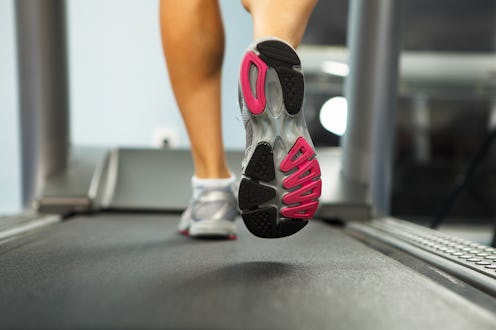Life
How To Buy The Right Running Shoes
New York Fashion Week was bombed with fitness-inspired trends this year, and the sporty girl inside us rejoiced at the fact that runways were swapping stilettos and crop tops for sweatpants and gym shoes. It's completely encouraged to embrace the athletic look all the time this year, but when it comes to your actual running shoes, you'll want to stray from the pack and give your feet some extra personal attention.
Every person's foot, running style, and of course, running frequency, is different, so what works for one runner may not cut it for another. Johanna Bjorken, merchandise director at JackRabbit Sports in New York City, reveals the top five mistakes that people make when looking for a new pair of kicks.
Dodge these blunders and your feet will thank you.
Heading to the Mall
The mall is a great place for things like last-minute Halloween costumes and those engraved photo frames you give as wedding presents to couples you barely know. But for running shoes, you'll want to head to a proper running store.
The prices may be a tad more expensive, but think: If you're spending just 30 minutes each day in your sneaks, it's worth it to throw down a couple extra bucks to ditch blisters and pain. Good running stores will do an in-depth analysis of your foot to help you find the perfect pair.
Paying Too Much Attention to Arches
The thinking used to be that this tiny body part — your arches — should play the biggest role in determining what shoes you would buy. Enter advances in running technology and foot analysis (yes, that's a thing) and the running world realized there's so much more to shoe fit.
"How high or low your arches are may be a good indication of how rigid or flexible your foot is, but not how strong," Bjorken says. Experts will also take into account other variables such as pronation (the inward transfer of weight during impact), where the foot strikes the ground, and how often you actually plan on hitting the pavement.
Being a Shallow Copycat
Being shallow, or a copycat, is never admirable and especially not when it comes to sneakers. Shoes are just not a one-size-fits-all kind of deal. Your friend's kicks might look great, but it is not likely your foot shape will match. The shoes that fit her and suit her running style may not be right for you, Bjorken notes.
Beauty alone is not a virtue. "Loving the way your shoes look can be a great motivator to putting them on, but if they’re wrong for you, you’re not going to wear them at all," Bjorken says.
Getting Stuck on the Size
Your shoe size, that is. "Running shoes can be measured slightly different than fashion footwear, so don’t be surprised if you need a half to full size bigger," Bjorken says.
How should sneaks fit? She says feet expand when you run because it’s one of the ways your body naturally absorbs shock. "The shoe should fit securely, without slippage, in the heel and around the middle of your foot, but there should be space in the forefoot for your toes to wiggle around, and about one centimeter between the end of your longest toe and the end of the shoe," she says.
Wanting to Break Them in
Running experts will tell you the entire concept of "breaking in" is more of a myth than a maxim. "Running shoes should be comfortable from day one. If they are uncomfortable in the store, they’re not going to improve with age," she says.
If the kicks hurts before you even make a purchase, ditch them.
Image Credit: Sergey Nivens/Fotolia
